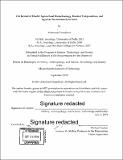| dc.contributor.advisor | Michael Fischer. | en_US |
| dc.contributor.author | Chaudhuri, Ashawari. | en_US |
| dc.contributor.other | Massachusetts Institute of Technology. Program in Science, Technology and Society. | en_US |
| dc.coverage.spatial | a-ii--- | en_US |
| dc.date.accessioned | 2020-03-09T18:52:13Z | |
| dc.date.available | 2020-03-09T18:52:13Z | |
| dc.date.copyright | 2019 | en_US |
| dc.date.issued | 2019 | en_US |
| dc.identifier.uri | https://hdl.handle.net/1721.1/124070 | |
| dc.description | Thesis: Ph. D. in History, Anthropology, and Science, Technology and Society (HASTS), Massachusetts Institute of Technology, Program in Science, Technology and Society, 2019 | en_US |
| dc.description | Cataloged from PDF version of thesis. | en_US |
| dc.description | Includes bibliographical references (pages 254-271). | en_US |
| dc.description.abstract | Genetically modified (GM) cotton, Bt cotton was introduced in India in 2002 through a joint venture company, Mahyco-Monsanto Biotech (India) Private Limited (MMB). It is a collaboration between the Indian agricultural company, Maharashtra Hybrid Seed Company (Mahyco), and the U.S. based agrochemical company, Monsanto, which is now acquired by byer. The way it translated in practice was that, the Indian seed companies purchased seeds from MMB and through conventional breeding techniques, made crosses between plants containing the Bt gene with cotton plants that are owned by the companies. From the very beginning of legalization of genetically modified Bt cotton, it emerged as the seed of certitude and doubt, of truth and ruse, of promise and disbelief at the same time. Debates were already brewing about the advantages of using transgenic cotton seeds as early as 2003. | en_US |
| dc.description.abstract | From "remarkable success", because of higher yields making India the second largest producer of cotton in the world, to "continuous failure" due to the increased resistance of the pests developed against Bt cotton over the years, to relating the use of transgenic seeds with massive debt cycles and farmers' suicides and large scale protests, the debate over the advantages or disadvantages of using transgenic seeds have been fierce and muddled. As Glenn Stone points out in "Constructing Facts", these opposing camps have their own "authenticating systems" that constructed their own "rules for facticity", while nullifying all others (Stone 2012). This dissertation explores these radically different entailments of the introduction of a GM crop. My work is shaped by my long-standing desire to understand how agrarian lives and experiences might inform narratives of science and the environment at national and global scales. | en_US |
| dc.description.abstract | Some of the questions that this dissertation explores are, how do different communities like farmers, scientists, regulators who are positioned on opposing ends of the agrarian political economy, understand and work with GM seeds? What are the modes of analysis, abstraction and writing about them emerge in these different sites as the materiality of the seeds get constantly entwined with the practices and experiences of the communities I study? What remains and what gets submerged when we understand biotechnology in terms of partnerships between corporate enterprises and academia, biocapital, risk studies, or cost-benefit analysis? | en_US |
| dc.description.statementofresponsibility | by Ashawari Chaudhuri. | en_US |
| dc.format.extent | 271 pages | en_US |
| dc.language.iso | eng | en_US |
| dc.publisher | Massachusetts Institute of Technology | en_US |
| dc.rights | MIT theses are protected by copyright. They may be viewed, downloaded, or printed from this source but further reproduction or distribution in any format is prohibited without written permission. | en_US |
| dc.rights.uri | http://dspace.mit.edu/handle/1721.1/7582 | en_US |
| dc.subject | Program in Science, Technology and Society. | en_US |
| dc.title | The kernel of doubt : agricultural biotechnology, braided temporalities, and agrarian environments in India | en_US |
| dc.title.alternative | Agricultural biotechnology, braided temporalities, and agrarian environments in India | en_US |
| dc.type | Thesis | en_US |
| dc.description.degree | Ph. D. in History, Anthropology, and Science, Technology and Society (HASTS) | en_US |
| dc.contributor.department | Massachusetts Institute of Technology. Program in Science, Technology and Society | en_US |
| dc.identifier.oclc | 1142185968 | en_US |
| dc.description.collection | Ph.D.inHistory,Anthropology,andScience,TechnologyandSociety(HASTS) Massachusetts Institute of Technology, Program in Science, Technology and Society | en_US |
| dspace.imported | 2020-03-09T18:52:12Z | en_US |
| mit.thesis.degree | Doctoral | en_US |
| mit.thesis.department | STS | en_US |
